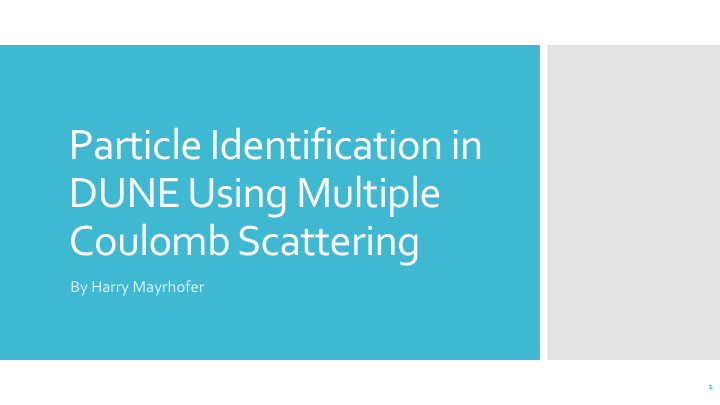



Particle Identification in DUNE Using Multiple Coulomb Scattering By Harry Mayrhofer 1
The Neutrino & DUNE The Neutrino - incredibly small, chargeless particles that interact very weakly with matter Really hard to detect, but they have the potential to lead to new physics DUNE – Deep Underground Neutrino Experiment LArTPC – Liquid Argon Time Projection Chamber ProtoDUNE – DUNE’s [1] prototype 2
Neutrino interactions Fire a lot of neutrinos into a lot of liquid argon Particles created ionize electrons y Fig 1 in [3], z coordinate x axis added Wire number (z axis) Drift Graphed using Time Larsoft’s Event (x Display program axis) 3
What particles come flying off, and what are their energies and momenta? Particle Primary Candidate particles: Identification Proton (PID) Muon Pion (π + ) } Have similar rest mass, but behave differently as they pass through matter 4
As a particle travels through Argon, it collides with electrons, losing energy at a mean rate !" !# as described by Hans Bethe In general, muons will lose energy more slowly PID Methods and make longer tracks than protons However, a muon and a proton can make similar length tracks if the proton has a much larger momentum than the muon From [2], fig 33.2 5
An incident particle interacting with argon nuclei by Coulombic forces replicates nearly elastic collisions that cause the particle to change direction A stochastic process around a Gaussian distribution, where - . /+ . ) 𝜄 %&' ~ *+ = [3] Multiple + . In order for a proton and a muon to create similar track lengths, Coulomb the proton would need to have a higher momentum than a muon Scattering (MCS) 6
𝜄 7 𝜄 ) Based on an algorithm designed by the MicroBooNE collaboration [3] On some given track with some pattern of scattering angles, calculate the likelihood 𝑀 that a particle scatters through those angles for a range of starting momenta. Return the highest Applying likelihood & its associated momentum. Theory of MCS The algorithm requires a hypothesis about the mass of the particle that made the fitted track Let be the negative log-likelihood of an outcome; that is, ℒ = −ln(𝑀) , where 𝑀 is the likelihood of an outcome. Minimizing is equivalent to maximizing 𝑀 7
Results From a simulation of 1000 muon events (p = 0.3 GeV/c) sent at a direction where 𝜄 = 𝜒 = 0 and run in DUNE’s geometry. Position information was collected from recobTrack data using the Pandora module. The data at the right represents all events that produced tracks with length greater than 70 cm 8
Results From a simulation of 1000 proton events (p = 1.0 GeV/c) sent at a direction where 𝜄 = 𝜒 = 0 and run in DUNE’s geometry. Position information was collected from recobTrack data using the Pandora module. The data at the right represents all events that produced tracks with length greater than 70 cm 9
Proton Interactions Protons can interact by the strong nuclear force. If a proton undergoes an inelastic collision or a hard scatter, then it will deflect more than Multiple Coulomb Scattering predicts 10
Figure out how to account for strong interactions in the multiple Further Coulomb scattering algorithm investigation One potential avenue of study is figuring out when hard scatters are being observed in the detector 11
Dr. Glenn Horton-Smith Dr. Tim Bolton Isabella Ginnett Acknowledgements Norman Martinez National Science Foundation Kansas State University Fermilab & the MicroBooNE collaboration 12
[1] https://www.dunescience.org/ [2] P. Abratenko et al [MicroBooNE collaboration] Determination of muon momentum in the MicroBooNE LArTPC using an improved References model of multiple Coulomb scattering 2017 JINST 12 P10010 [3] M. Tanabashiet al.[Particle Data Group] Passage of Particles Through Matter, Phys. Rev. D98, 030001 (2018) 13
: + ; ; 𝜄 %&' = < = (1 + 𝜗 ∗ ln < = ) , *+ D.)DF&GH 𝜆 𝑞 = + 11.004𝑁𝑓𝑊 + . 𝜗 = 0.038 𝑞 𝑛𝛾 𝛾 = 𝑞 = 𝑛𝛾𝛿 = 𝑛 7 + 𝑞 7 Equations 1 − 𝛾 7 𝑞 7 𝑞 7 = (𝑛𝛾) 7 𝛾𝑞 = 𝑛 7 + 𝑞 7 1 − 𝛾 7 𝑞 7 1 − 𝛾 7 = 𝑛 7 𝛾 7 𝑛 7 + 𝑞 7 1 𝑞 7 = 𝛾 7 𝑛 7 + 𝑞 7 𝛾𝑞 = 𝑞 7 𝑞 7 𝛾 7 = 𝑛 7 + 𝑞 7 14
Y plane U plane V plane 15
Graphed using ROOT 16
1) Break the track up into several line segments fit to linear regressions Multiple Coulomb Scatter fitting 17
1) Break the track up into several line segments fit to linear regressions Multiple Coulomb Scatter fitting 18
2) Find the deflection angles between each pair of segments Multiple Coulomb Scatter fitting 𝜄 7 𝜄 ) 19
3) Figure out the momentum that is most likely to have generated the track that was detected Multiple Coulomb Scatter fitting 𝜄 ) Use momentum associated with this gaussian distribution 20
Recommend
More recommend